| dc.contributor.author | Dockendorff, Chris | |
| dc.contributor.author | Faloon, Patrick W. | |
| dc.contributor.author | Germain, Andrew | |
| dc.contributor.author | Youngsaye, Willmen | |
| dc.contributor.author | Nag, Partha P. | |
| dc.contributor.author | Bennion, Melissa | |
| dc.contributor.author | Dandapani, Sivaraman | |
| dc.contributor.author | Perez, José R. | |
| dc.contributor.author | Munoz, Benito | |
| dc.contributor.author | Palmer, Michelle A. | |
| dc.contributor.author | Schreiber, Stuart L. | |
| dc.contributor.author | Yu, Miao | |
| dc.contributor.author | Penman, Marsha L | |
| dc.contributor.author | Nieland, Thomas J | |
| dc.contributor.author | Krieger, Monty | |
| dc.date.accessioned | 2017-02-03T16:14:04Z | |
| dc.date.available | 2017-02-03T16:14:04Z | |
| dc.date.issued | 2015-04 | |
| dc.date.submitted | 2015-03 | |
| dc.identifier.issn | 0960-894X | |
| dc.identifier.uri | http://hdl.handle.net/1721.1/106850 | |
| dc.description.abstract | A new series of potent inhibitors of cellular lipid uptake from HDL particles mediated by scavenger receptor, class B, type I (SR-BI) was identified. The series was identified via a high-throughput screen of the National Institutes of Health Molecular Libraries Small Molecule Repository (NIH MLSMR) that measured the transfer of the fluorescent lipid DiI from HDL particles to CHO cells overexpressing SR-BI. The series is characterized by a linear peptidomimetic scaffold with two adjacent amide groups, as well as an aryl-substituted heterocycle. Analogs of the initial hit were rapidly prepared via Ugi 4-component reaction, and select enantiopure compounds were prepared via a stepwise sequence. Structure–activity relationship (SAR) studies suggest an oxygenated arene is preferred at the western end of the molecule, as well as highly lipophilic substituents on the central and eastern nitrogens. Compound 5e, with (R)-stereochemistry at the central carbon, was designated as probe ML279. Mechanistic studies indicate that ML279 stabilizes the interaction of HDL particles with SR-BI, and its effect is reversible. It shows good potency (IC[subscript 50] = 17 nM), is non-toxic, plasma stable, and has improved solubility over our alternative probe ML278. | en_US |
| dc.language.iso | en_US | |
| dc.publisher | Elsevier | en_US |
| dc.relation.isversionof | http://dx.doi.org/10.1016/j.bmcl.2015.03.074 | en_US |
| dc.rights | Creative Commons Attribution-NonCommercial-NoDerivs License | en_US |
| dc.rights.uri | http://creativecommons.org/licenses/by-nc-nd/4.0/ | en_US |
| dc.source | Elsevier | en_US |
| dc.title | Discovery of bisamide-heterocycles as inhibitors of scavenger receptor BI (SR-BI)-mediated lipid uptake | en_US |
| dc.type | Article | en_US |
| dc.identifier.citation | Dockendorff, Chris et al. “Discovery of Bisamide-Heterocycles as Inhibitors of Scavenger Receptor BI (SR-BI)-Mediated Lipid Uptake.” Bioorganic & Medicinal Chemistry Letters 25.12 (2015): 2594–2598. | en_US |
| dc.contributor.department | Massachusetts Institute of Technology. Department of Biology | en_US |
| dc.contributor.mitauthor | Yu, Miao | |
| dc.contributor.mitauthor | Penman, Marsha L | |
| dc.contributor.mitauthor | Nieland, Thomas J | |
| dc.contributor.mitauthor | Krieger, Monty | |
| dc.relation.journal | Bioorganic & Medicinal Chemistry Letters | en_US |
| dc.eprint.version | Final published version | en_US |
| dc.type.uri | http://purl.org/eprint/type/JournalArticle | en_US |
| eprint.status | http://purl.org/eprint/status/PeerReviewed | en_US |
| dspace.orderedauthors | Dockendorff, Chris; Faloon, Patrick W.; Germain, Andrew; Yu, Miao; Youngsaye, Willmen; Nag, Partha P.; Bennion, Melissa; Penman, Marsha; Nieland, Thomas J.F.; Dandapani, Sivaraman; Perez, José R.; Munoz, Benito; Palmer, Michelle A.; Schreiber, Stuart L.; Krieger, Monty | en_US |
| dspace.embargo.terms | N | en_US |
| dc.identifier.orcid | https://orcid.org/0000-0003-2673-1672 | |
| dc.identifier.orcid | https://orcid.org/0000-0003-4541-5181 | |
| mit.license | PUBLISHER_CC | en_US |
| mit.metadata.status | Complete | |
